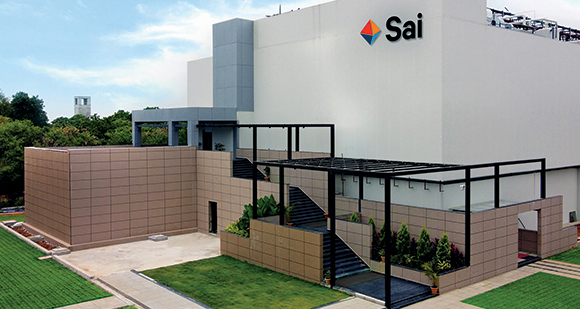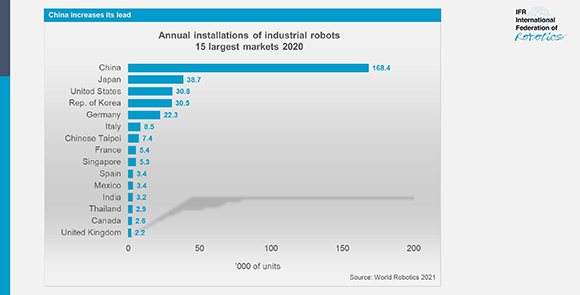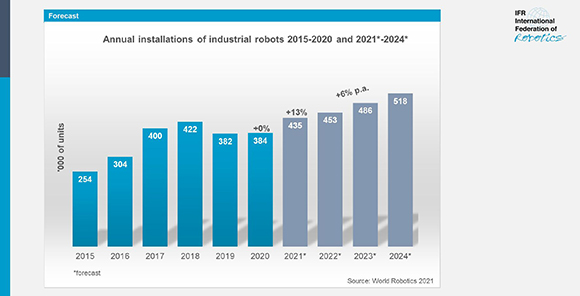|
  
|
FROM SITE SELECTION
MAGAZINE, SEPTEMBER 2021 ISSUE
|
 |
BIOTECH LOCATIONS
A journey through a growing Indian multinational’s past year casts light
on three leading biotech locations around the world.
|
|
|
CONWAY ANALYTICS
SNAPSHOT
|

|
The International Federation
of Robotics in Frankfurt, Germany, today released its World
Robotics 2021 Industrial Robots report, which shows a new record of 3
million industrial robots are operating around the world, an increase of
10% over last year. Asia, the world’s largest market for industrial
robots, saw 71% of all newly deployed robots globally in 2020.
“Installations for the region´s largest adopter China grew strongly by
20% with 168,400 units shipped,” says the IFR. “This is the highest
value ever recorded for a single country. The operational stock reached
943,223 units (+21%). The 1-million-unit mark will be broken in 2021.”
The electronics industry and the semiconductor industry are investing
heavily in Asia. The demand for robots both from the electronics
industry as well as from the automotive suppliers is expected to grow
substantially by 11% in 2021 and by 8% annually on average in the next
years following.
“Global robot installations are expected to rebound strongly and grow by
13% to 435,000 units in 2021, thus exceeding the record level achieved
in 2018,” says IFR President Milton Guerry. “Installations in North
America are expected to increase by 17% to almost 43,000 units.
Installations in Europe are expected to grow by 8% to almost 73,000
units. Robot installations in Asia are expected to exceed the
300,000-unit mark and add 15% to the previous year’s result. Almost all
Southeast Asian markets are expected to grow by double-digit rates in
2021.” Further details by world region are available on the IFR website.
|

|
SOCIAL MEDIA
A team of students in a strategic communications class taught by
Professor Michael Jones-Kelley of the Jandoli School of Communication at
St. Bonaventure University is working with Site Selection to help us
evaluate and refresh our social media presence and level of engagement.
Please take this brief survey to help us learn more about your social
media use and habits, as well as content preferences and interests: https://forms.gle/9M4MLK7cykcFnzry9
|
|
 |
|
Critical production demands can’t always wait on a lengthy construction
project. North Carolina’s shell industrial buildings are ready now with
targeted state and local incentives available to help with up-fit.
At ElectriCities, we look for opportunities to partner with our 70+ NC
Public Power member cities to provide customized assistance within all
aspects of economic development at no cost to you. From marketing to
targeted recruiting to grant assistance, we’re here with tools and
expertise. We actively work with site selectors to recruit industries
and bring jobs to our public power hometowns. Our local expertise allows
commercial and industrial customers like you to find just the right site
with fewer hassles—and way more hospitality.
READY TO GET STARTED? Contact Brenda Daniels at 800.768.7697 ext. 6363
or bdaniels@electricities.org.
Click to see some of our featured shell buildings below, with more
coming on the market every month.
|
|
  |
New York
Hiram, Ohio–based Great Lakes Cheese Co. has chosen to close its plant
in Cuba, New York, and open this new $505 million plant on a site
located in the towns of Franklinville and Farmersville in Cattaraugus
County — not far from St. Bonaventure University. The project involves
the addition of 200 new jobs as well as job offers to the 226 workers at
the Cuba location about 15 miles to the southeast. The plant is
projected to be ready to occupy by early 2025. The Cattaraugus County
Industrial Development Agency approved a payment in lieu of taxes
agreement with the company. “It is estimated the plant will be able to
take in 4 million gallons of milk a day for cheese production,
supporting 600 agricultural jobs in the region,” the Olean Times Herald
reported, noting that county lawmakers approved a $5.8 million
allocation to improve municipal water and sewer lines to the site. Great
Lakes Cheese is one of 6,549 ESOPs (employee stock ownership plans) in
the U.S., in a state which, like the company’s home state of Ohio, has a
high concentration of them. It operates four “super-plants” in its
hometown of Hiram, Ohio; Plymouth, Wisconsin; Fillmore, Utah; and
Manchester, Tennessee; two other production plants in Adams, New York,
and La Crosse, Wisconsin; and one specialty cheese packaging plant in
Wausau, Wisconsin.
California
Originally announced in spring 2020, a second facility opened this month
in Carlsbad on the campus of MilliporeSigma, the U.S. and Canadian life
science business of Darmstadt, Germany–based Merck KGaA. The project
more than doubles the site’s production capacity to support
commercialization and industrialization of viral vectors and enables
suspension production of viral vectors up to 1,000-liter scale. The
viral gene therapy market is expected to grow to $10 billion by 2026.
Between the two facilities, there are 30 cleanroom suites to support all
aspects of manufacturing from small- to large-scale clinical and
commercial production. “We are continuing to invest in solving cell and
gene therapy challenges in development and manufacturing, working
alongside drug developers to industrialize, scale and accelerate the
path to deliver therapies to patients,” said Matthias Heinzel, Member of
the Executive Board and CEO, Life Science, Merck KGaA.
|
|
  |

|
FINANCIAL SERVICES
Missouri’s global reach in financial services is strengthened by its
global potential.
|
|
|
|
 |
WORKFORCE
Missouri One Start offers a variety of services to help employers with
recruitment and training.
|
|
 |
ST. LOUIS
This 15-county metro is home to 39% of the state’s workforce.
|
|
|
SITE SELECTION
RECOMMENDS
|

|
The Canary Wharf district in London Photo
courtesy of London & Partners
|
|
|
What would a parking technology company know about smart cities? Quite a
lot, apparently. Sweden-based EasyPark Group, which operates in 3,200 of
the world’s cities, earlier this month released the 2021 edition of its
Cities of the Future Index, which analyzes
several thousand cities across a range of 14 factors related to their
adoption of technology in four areas: Digital Life, Mobility Innovation,
Business Tech Infrastructure, Sustainability. By population category:
- London, UK, ranks as the most intelligent and future-proof city with
a population of over 3 million people, followed by New York, USA,
and San Francisco, USA.
- Copenhagen, Denmark, ranks as the most intelligent and future-proof
city with a population of between 600,000 and 3 million people,
followed by Stockholm, Sweden, and Oslo, Norway.
- Lund, Sweden, ranks as the most intelligent and future-proof city
with a population of between 50,000 and 600,000 people, followed by
Stavanger, Norway, and Espoo, Finland.
|
|

|
Photo courtesy of Richard Nenoff
|
|
The dividing line between Piedmont Heights and Ansley Park in Atlanta is
where Site Selection Lead Designer Richard Nenoff finds the overlap
between creepiness and downright horror at a neighbor’s giant
jack-in-the-box. For Richard, the scary season is the most important
holiday season of all, just like horror movies are the most important
films. Why do clowns creep us out? He has some thoughts: “I think
there’s this moment in life where things that are fun in childhood
become creepy as adults. You can blame Pennywise from “It,” but I think
clowns were scary before that, kinda like dolls were scary before Chucky
in “Child’s Play.” I think it has to do with the face. Humans learn
subconsciously to read so many cues from facial expressions, but clowns
have these exaggerated expressions painted on, so it’s harder to read
their true feelings and emotions, y’know? I think we’ve evolved to
distrust people who don’t emote or we can’t read. That’s what makes
dolls, mannequins, clowns and people in masks creepy.” So … Happy
Halloween? (shudder)
|
|
|
|

